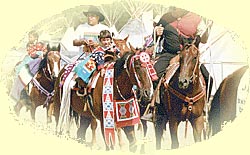Um-basax-bilua: In 1904, in an attempt to encourage Absalooka farmers to improve their skills, S. C. Reynolds, the Indian Affairs agent assigned to Crow Agency, Montana, decided to set up a rural fair where people could exhibit their produce, foods and baked goods, as well as handicrafts. Various categories were established and ribbons and cash prizes awarded. Reynolds made an exception to government policy and allowed tribal dances, ceremonies and singing to take place. Various forms of entertainment such as foot races, horse racing, mock battles, parades, victory dances and gift giving were also organized. By 1905, Crow Agency had a one-half-mile horse race track and an exhibit hall. Over the years, a number of events were added to Um-basax-bilua (Crow Fair), and by 1920, dancing exhibitions and a rodeo had been established. Um-basax-bilua is known today as the Teepee Capital of the World. Twenty to thirty thousand Aboriginal people from the United States and Canada gather there to participate in, and see, a village of almost 1,000 tipis, horse and decorated-vehicle parades, horse races, and an all-Native rodeo in which about 700 cowboys compete. Joseph Medicine Crow, From the Heart of the Crow Country: The Crow Indians' Own Stories
page 1 | page 2 | page 3 | page 4 | page 5 | page 6 | page 7 | page 8 Introduction | What makes Native Rodeo Different? | History of Rodeo Associations | Rodeo Heroes | The Rodeo Arena | The Rodeo Circuit | Rodeo Events | Down the Road SACRED BEINGS | RANCHING | ENTERTAINMENT | RODEO | ARTS AND INDUSTRIES |


